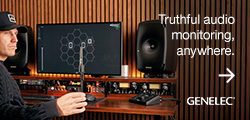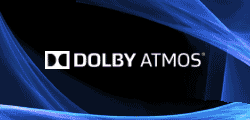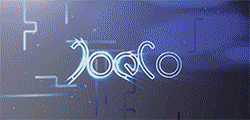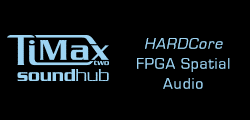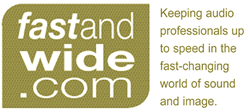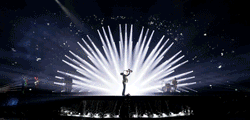![]() Staged around every 20 years, the spectacular ‘once-in-a-generation’ Fête des Vignerons event takes over the Swiss town of Vevey for a month at the end of July and beginning of August.
Staged around every 20 years, the spectacular ‘once-in-a-generation’ Fête des Vignerons event takes over the Swiss town of Vevey for a month at the end of July and beginning of August.
Featuring nearly 6,400 performers, musicians and singers supported by 612 loudspeakers, upwards of 300 channels of wireless microphones, 11 networked Yamaha digital mixing systems for the 2019 event.
Fête des Vignerons pays homage to the centuries-old traditions of the Brotherhood of Winegrowers, which covers the area from Pully to Vevey, in the Lavaux region of Switzerland. The centrepiece production takes place in a temporary arena on the banks of Lac Léman (Lake Geneva) and depicts a year in the life of the vineyard over 20 scenes. The production comprised 23 shows plus the Coronation of the Vigneron-Tâcheron (wine-grower’s hand), traditionally regarded as the ‘keeper of the immemorial know-how’, and saw a quantum leap in the staging and production since it last took place in 1999.
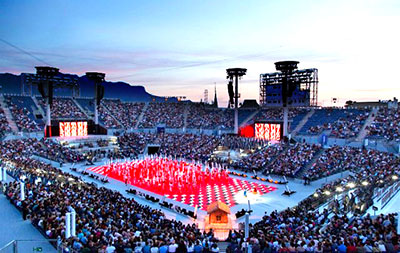 The show’s design was for five stages – one in the centre, plus one on each side of the arena – so sound coverage was a complex issue. For the 1999 event, the audio system was mounted on a single, central tower. This year, technical director François Mottier and artistic director Daniele Finzi Pasca were keen to address the issue of sound localisation.
The show’s design was for five stages – one in the centre, plus one on each side of the arena – so sound coverage was a complex issue. For the 1999 event, the audio system was mounted on a single, central tower. This year, technical director François Mottier and artistic director Daniele Finzi Pasca were keen to address the issue of sound localisation.
Martin Reich, head of Swiss company Audioconsulting, oversaw the audio concept and system design, working with Gregor Baumann. Digital networking meant that Reich could give each of the five stages its own PA system that would cover the whole arena. This was achieved with eight main PA towers, plus surround speakers and fills around the outside and the centre of the arena and subwoofers under the seating. ‘This was the best solution in a situation where any part of the PA could be 130m from the furthest audience point,’ he says.
With a cast of 5,500 actors, more than 900 singers and musicians, plus a pre-recorded score by the Gstaad Festival Orchestra, Reich chose Yamaha digital mixing systems on twin Dante networks to handle the many audio channels, including 324 channels of Shure Axient digital wireless microphones.
‘I realised that we would have to put everything in place once we were on site, because we wouldn’t necessarily have the information we needed up front. Dante would allow that, because it only needs a click of a mouse to change something quickly and reliably,’ he says.
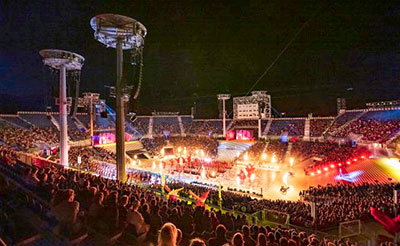 ‘The advantages of Yamaha Rivage PM series digital mixing systems were the sound quality, flexibility and the high channel count available on Dante – here we had 288 inputs on each system. Another was that there is a high degree of integration between the two. And with these also came great reliability. With Yamaha we knew exactly what we would get.’
‘The advantages of Yamaha Rivage PM series digital mixing systems were the sound quality, flexibility and the high channel count available on Dante – here we had 288 inputs on each system. Another was that there is a high degree of integration between the two. And with these also came great reliability. With Yamaha we knew exactly what we would get.’
For 2019, the organising committee wanted to work with a single dry hire material provider, with French group Dushow winning the tender. In April 2019 Dushow’s Swiss partner Hyperson hosted an in-depth technical seminar for the audio crew, with Yamaha’s Andy Cooper, Delphine Hannotin and Jean-Pierre Decollogny also training engineers on the Rivage PM systems. Also in April part of the crew travelled to Dushow’s Paris Roissy premises where a full audio network buildup and test took place.
Reich’s choice of three Yamaha Rivage PM10 and six PM7 digital mixing systems was a practical answer to dealing with more than 1,000 performers and five stages: ‘We put a Rivage PM7 and two Rio3224-D2 I/O units on each stage, with a second PM7 on the main stage,’ says Martin. ‘The sheer number of inputs meant that pre-mixing was essential to reduce the individual workloads, so I added two Rivage PM10s for mixing the choirs and a third PM10 for mixing the brass band. The premixed stems were then routed to the PM7s, where the engineers mixed them with the live signals from each stage.’
The networking was designed by Reich’s assistant and the event’s head of IP networks, Gregor Baumann. He chose two parallel Dante networks – one for the live audio inputs to the Rivage PM systems and from them to the PA, the second for playback of backing tracks, live recording and virtual soundchecking – because it allowed the two Yamaha Nuage systems and the four 128-track recorders to be used as a recording pool, which could be assigned dynamically per production day.
‘Virtual soundchecking was a breeze and the Rivage PM systems saved us a lot of time,’ says head of premixes Julian Fehlmann. ‘With hundreds of channels, having the copy and paste functions close at hand for any type of setting was a huge time-saver. I believe that’s a major point for being in the digital environment, yet is something that some brands don’t seem to have thought about too much.’
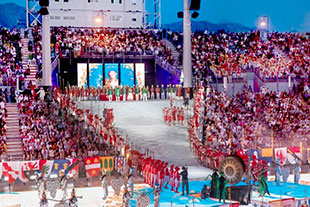 Nuage had been a core part of the production from the outset, used to record the orchestral score: ‘We pre-recorded the Gstaad Festival Orchestra, because we were not able to move it fast enough from one stage to another during the production,’ Reich says. ‘We could have put it under the stage but we felt that, if you cannot see it, you might as well pre-record it.’
Nuage had been a core part of the production from the outset, used to record the orchestral score: ‘We pre-recorded the Gstaad Festival Orchestra, because we were not able to move it fast enough from one stage to another during the production,’ Reich says. ‘We could have put it under the stage but we felt that, if you cannot see it, you might as well pre-record it.’
Used for the live playback of the orchestral score and sound effects, as well as recording and playing back rehearsals for the virtual soundchecks, another advantage of using Nuage was, like the Rivage PM systems, its close integration with Dante.
‘Nuage and Nuendo really became the studio tools of the Fête,’ says head of SFX and virtual soundcheck, David Weber. ‘The design of the audio system meant that we could use a lot of surround effects. Also, as the show developed during rehearsals, timings changed and I was able to make some pieces of the music shorter or longer.’
The Nuage system was also used to create alternative monitor mixes, where the dynamic sound of the orchestra was needed for playback, but for some of the performers’ in-ear monitors it was better to have a less dynamic mix.
The number of wireless microphone channels meant that the entire bandwidth from 400-700MHz was needed, with the Axient receivers all connected via Yamaha Dante interface cards to Macintosh computers running Wavetools monitoring software. RF over fibre was also run to transmitters at various locations, some of which were over a kilometre away from the central monitoring location, allowing system checks via iPad.
Reich’s confidence in the audio system was well-rewarded: ‘My main concern was about the network, but we used it 24/7 for all the sound, as well as all the communications, and we didn’t have a single hitch,’ he reports. ‘Gregor did an incredible job. It meant I was able to sleep at night.’
More: www.yamahaproaudio.com




